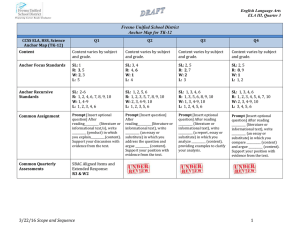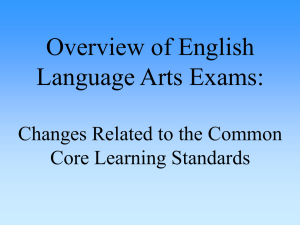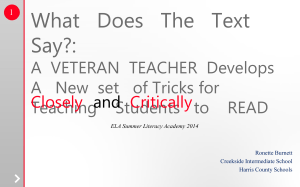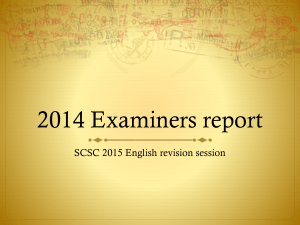Scope and Sequence ENG III Quarter 1
advertisement
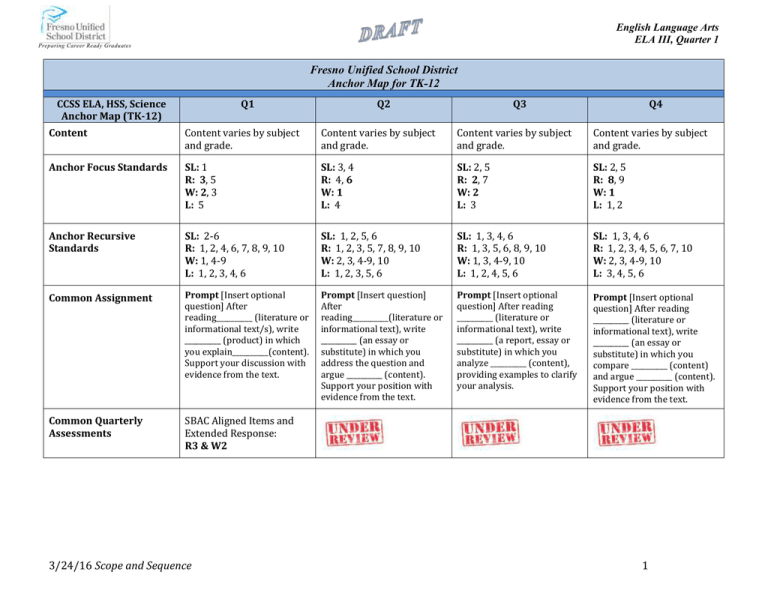
English Language Arts ELA III, Quarter 1 Preparing Career Ready Graduates Fresno Unified School District Anchor Map for TK-12 CCSS ELA, HSS, Science Anchor Map (TK-12) Q1 Q2 Q3 Q4 Content Content varies by subject and grade. Content varies by subject and grade. Content varies by subject and grade. Content varies by subject and grade. Anchor Focus Standards SL: 1 R: 3, 5 W: 2, 3 L: 5 SL: 3, 4 R: 4, 6 W: 1 L: 4 SL: 2, 5 R: 2, 7 W: 2 L: 3 SL: 2, 5 R: 8, 9 W: 1 L: 1, 2 Anchor Recursive Standards SL: 2-6 R: 1, 2, 4, 6, 7, 8, 9, 10 W: 1, 4-9 L: 1, 2, 3, 4, 6 SL: 1, 2, 5, 6 R: 1, 2, 3, 5, 7, 8, 9, 10 W: 2, 3, 4-9, 10 L: 1, 2, 3, 5, 6 SL: 1, 3, 4, 6 R: 1, 3, 5, 6, 8, 9, 10 W: 1, 3, 4-9, 10 L: 1, 2, 4, 5, 6 SL: 1, 3, 4, 6 R: 1, 2, 3, 4, 5, 6, 7, 10 W: 2, 3, 4-9, 10 L: 3, 4, 5, 6 Common Assignment Prompt [Insert optional question] After reading__________ (literature or informational text/s), write __________ (product) in which you explain__________(content). Support your discussion with evidence from the text. Prompt [Insert question] After reading__________(literature or informational text), write __________ (an essay or substitute) in which you address the question and argue __________ (content). Support your position with evidence from the text. Prompt [Insert optional question] After reading __________ (literature or informational text), write __________ (a report, essay or substitute) in which you analyze __________ (content), providing examples to clarify your analysis. Prompt [Insert optional question] After reading __________ (literature or informational text), write __________ (an essay or substitute) in which you compare __________ (content) and argue __________ (content). Support your position with evidence from the text. Common Quarterly Assessments SBAC Aligned Items and Extended Response: R3 & W2 3/24/16 Scope and Sequence 1 English Language Arts ELA III, Quarter 1 Preparing Career Ready Graduates Quarter 1, Grades 6-12 Content Map ELA History/Social Studies Science Content Inquiry and Communication CA H/SS Content Standards through the C3 Inquiry Arc Framework CA Science Standards and Next Generation Science Standards Focus Standards SL: 1 RL & RI: 3, 5 W: 2, 3 L: 5 SL: 1 RHSS: 3, 5 WHSS: 2 SL: 1 RST: 3, 5 WST: 2 SL: 2-6 RL & RI: 1, 2, 4, 6, 7, 8, 9, 10 W: 1, 4-9 L: 1, 2, 3, 4, 6 SL: 2-6 RHSS: 1, 2, 4, 6, 7, 8, 9, 10 WHSS: 1, 4-9 L: 1-6 SL: 2-6 RST: 1, 2, 4, 6, 7, 8, 9, 10 WST: 1, 4-9 L: 1-6 Prompt [Insert optional question] After reading__________ (literature or informational text/s), write __________ (product) in which you explain__________(content). Support your discussion with evidence from the text. Prompt [Insert optional question] After reading__________ (literature or informational text/s), write __________ (product) in which you explain__________(content). Support your discussion with evidence from the text. Prompt [Insert optional question] After reading__________ (literature or informational text/s), write __________ (product) in which you explain__________(content). Support your discussion with evidence from the text. SBAC Aligned Items and Extended Response: R3 & W2 SBAC Aligned Items and Extended Response: R3 & W2 SBAC Aligned Items and Extended Response: R3 & W2 Recursive Standards Common Assignment Common Quarterly Assessment 3/24/16 Scope and Sequence 2 English Language Arts ELA III, Quarter 1 Preparing Career Ready Graduates Unit 1 Overview The Conversation Drives Content and Skill Acquisition Focus Standards RL & RI: 3, 5; W: 2, 3; SL: 1; L: 5 Recursive Standards RL & RI: 1, 2, 4, 6, 7, 8, 9, 10; W: 1, 4-9; SL: 2-6; L: 1, 2, 3, 4, 6 ELD Standards Highlight complementary ELD standards that include interacting in meaningful ways (Section 1/Part I), learning about how English works (Section 1/Part II), all using foundational literacy skills (Section 1/Part III), all grounded in texts and discourse in context (Section 2). Anchor Texts Reading & Listening to Complex Texts Suggested Related Texts At least one of the following texts will anchor the set: *Lexile Range: 1215-1355L *Three Dimensions of Text Complexity: Suggested literary, informational, and non-print texts to provide additional opportunities to explore the essential and supporting questions through reading, writing, and talking. In combination with the anchor text, these texts may add depth, provide a range of ideas, and provide scaffolds for learning. Additional texts should be selected with attention to the three dimensions of text complexity. Novel Excerpts The Joy Luck Club (excerpt) Interpreter of Maladies (excerpt) Anthology Selections Novels: The Grapes of Wrath Lexile: 870L The quantitative Lexile level of 680 reflects the grade band of 4-5. However, the qualitative review identifies this text as very complex due to meaning and purpose, historical knowledge demands, and language features. Based on these sets of measures, this text is appropriate for an anchor text at 11th grade. FUSD core works . The Great Gatsby Lexile: 1070L The quantitative Lexile level of 1070 reflects the grade band of 6-8. However, the qualitative review identifies this text as very complex due to meaning and purpose, historical knowledge demands, and language features. Based on these sets of measures, this text is appropriate for an anchor text at 11th grade. FUSD core works . 3/24/16 Scope and Sequence Black Elk Speaks John Smith Letters Crevecour-Letters from an American Farmer “Mother Tongue” Amy Tan Seventeen Syllables by Hisaye Yamamoto Adolescence—III by Rita Dove I Stand Here Ironing by Tillie Olsen Ironing Their Clothes by Julia Alvarez Chicago by Carl Sandburg Lucinda Matlock by Edgar Lee Masters We Wear the Mask by Paul Laurence Dunbar Sympathy by Paul Laurence Dunbar Winter Dreams by F. Scott Fitzgerald America and I by Anzia Yezierska The New Immigrants by The Americans In the American Society by Gish Jen My Father and the Figtree by Naomi Shihab Nye Refugee Ship by Loma Dee Cervantes All of the native American traditions pieces: “The World on the Turtle’s Back” Song of the Sky Loom Writing & Speaking to Texts Writing to Learn Routine writing: Includes short constructed responses to text-dependent questions, note-taking, brainstorming ideas, learning logs, writing-to-learn tasks, and crafting summaries in response to text. Analyses: Emphasizes the use of evidence, as well as crafting works that display logical integration and coherence. These responses can vary in length based on the questions asked and tasks performed. Analyses serve as both formative and summative assessments of students’ ability to paraphrase, infer, and ultimately integrate the ideas they have gleaned from what they have read. Narratives: Offers students opportunity to express personal ideas and experiences through stories and descriptions. Deepens their understanding of literary concepts, structures, and genres through purposeful imitation. Provides additional opportunities for students to reflect on what they read through imaginative writing and practice with sequencing events and ideas through narrative descriptions. Product types: Represent the ability to communicate through various socially constructed representational forms. Examples include: Composition: Argumentative writing, informational/explanatory writing, narrative writing, analytical writing, literary/rhetorical analysis of text, written response to text. 3 English Language Arts ELA III, Quarter 1 Preparing Career Ready Graduates The Joy Luck Club Lexile: 930L The quantitative Lexile level of 930 reflects the grade band of 6-8. However, the qualitative review identifies this text as very complex due to meaning and purpose, historical knowledge demands, and language features. Based on these sets of measures, this text is appropriate for an anchor text at 11th grade. FUSD core works . Short Stories: “The Devil and Tom Webster” Lexile: Not available The qualitative review identifies this text as very complex due to meaning and purpose, historical knowledge demands, and language features. Based on these sets of measures, this text is appropriate for an anchor text at 11th grade. Literary Non-Fiction: I Know Why the Caged Bird Sings Lexile: 1070L The quantitative Lexile level of 1070 reflects the grade band of 9-10. However, the qualitative review identifies this text as very complex due to meaning and purpose, historical knowledge demands, and language features. Based on these sets of measures, this text is appropriate for an anchor text at 11th grade. Letters From an America Farmer: What is an American? Letter III Lexile: 1150L The quantitative Lexile level of 1150 reflects the grade band of 9-10. However, the qualitative review identifies this text as very complex due to meaning and purpose, historical knowledge demands, and language features. Based on these sets of measures, this text is appropriate for an anchor text at 11th grade. Plays: Death of a Salesman Lexile: 1320L The quantitative Lexile level of 1320 reflects the grade band of 11-12 and is 3/24/16 Scope and Sequence Hunting Song Coyote Stories The explorers The log of Christopher Columbus, La Relacion Of Plymoth Plantation I, Too Harlem The Weary Blues Expository/Informational Texts “Letters to the Valley, A Harvest of Memories” Masumoto Obama/Putin NYTimes op-eds about American exceptionalism “Sikh Army Captain Graduates: Tejeep Singh Rattan Sikh US Army Officer in Decades” article by Michelle Roberts http://www.tolerance.org/lesson/changing-demographics-changingidentity-changing-attitudes Death of A Salesman Expository text links: http://learning.blogs.nytimes.com/2012/02/16/teaching-death-of-asalesman-with-the-new-york-times/ http://www.nytimes.com/2012/05/03/opinion/death-of-a-salesmansdreams.html?_r=2& Op-Ed: American identity crisis? What’s an ‘American’ identity? http://digitaljournal.com/article/264177#ixzz2VSJ3nkIC Is the US still the land of Opportunity? http://www.nytimes.com/roomfordebate/2012/01/08/is-the-us-still-aland-of-opportunity Crossing the Line Between “Immigrant” and “American” http://www.nytimes.com/roomfordebate/2012/11/15/howimmigrants-come-to-be-seen-as-americans End-game of the tea party movement http://www.renewamerica.com/columns/cherry/130607 Discussion: Oral response to text, oral presentations of arguments/information, group discussions. Reflection: Written and oral reflections of experiences readings, writings, listening, speaking, and viewing. Suggested Range of Products: Biographical/autobiographical narrative Expository composition Business letter Debate Speech Essay Mock Trial Powerpoint w/accompanying essay Video Art project w/accompanying essay Non-Print Texts Economics and the American Dream-video http://www.ted.com/talks/richard_wilkinson.html Video part 1: What Does it Mean to be an American? Video part 2: What Does it Mean to be an American? American Gothic-Homer Winslow http://www.artic.edu/aic/collections/artwork/6565 Nature and the American Identity http://xroads.virginia.edu/~cap/nature/cap2.html Imagining the American West in the Late Nineteenth Century http://publications.newberry.org/teacherdocs/dcc/doc_downloads/12- 4 English Language Arts ELA III, Quarter 1 Preparing Career Ready Graduates qualitatively complex. Based on these sets of measures, this text is appropriate for an anchor text at 11th grade. FUSD core works. 13%20Stevens%20American%20West.pdf Raisin in the Sun Lexile: 970L The quantitative Lexile level of 970 reflects the grade band of 4-5. However, the qualitative review identifies this text as very complex due to meaning and purpose, historical knowledge demands, and language features. Based on these sets of measures, this text is appropriate for an anchor text at 11th grade. FUSD core works . Poetry: “Out, Out” Lexile: Not Available The qualitative review identifies this text as very complex due to meaning and purpose, historical knowledge demands, and language features. Based on these sets of measures, this text is appropriate for an anchor text at 11th grade. “Richard Corey” & “Miniver Cheevy” Lexile: Not Available The qualitative review identifies this text as very complex due to meaning and purpose, historical knowledge demands, and language features. Based on these sets of measures, this text is appropriate for an anchor text at 11th grade. 3/24/16 Scope and Sequence 5 English Language Arts ELA III, Quarter 1 Preparing Career Ready Graduates The Common Assignment: Responding to the Conversation **Each AC needs to develop and deliver at least one common assignment, which reflects the two focus standards. Common Assignment Prompt Frame (Insert optional question) After reading __________(literature or informational text/s), write __________(product) in which you explain __________(content). Support your discussion with evidence from the text. 3/24/16 Scope and Sequence Sample Common Assignment After reading Hamlet’s “To Be or Not To Be” soliloquy, write 2-3 paragraphs about how Shakespeare relates elements of Hamlet’s character as you explain how the action is ordered and Hamlet’s character is developed. 6 English Language Arts ELA III, Quarter 1 Preparing Career Ready Graduates LDC Informational/Explanatory Teaching Task Rubric *Template Task Collection Version 2.0 Scoring Elements Focus Controlling Idea Reading/ Research Development Organization Conventions Content Understanding Not Yet 1 Approaches Expectations 1.5 2 Meets Expectations 2.5 3 Advanced 3.5 4 Addresses prompt appropriately, but with a weak or uneven focus. Addresses prompt appropriately and maintains a clear, steady focus. D: Addresses additional demands sufficiently. Addresses all aspects of prompt appropriately and maintains a strongly developed focus. D: Addresses additional demands with thoroughness and makes a connection to controlling idea. Establishes a controlling idea with a general purpose. Establishes a controlling idea with a clear purpose maintained throughout the response. Establishes a strong controlling idea with a clear purpose maintained throughout the response. Presents information from reading materials relevant to the purpose of the prompt with minor lapses in accuracy or completeness. Presents information from reading materials relevant to the prompt with accuracy and sufficient detail. Accurately presents information relevant to all parts of the prompt with effective selection of sources and details from reading materials. Attempts to provide details in response to the prompt, including retelling, but lacks sufficient development or relevancy. Presents appropriate details to support the focus and controlling idea. Presents appropriate and sufficient details to support the focus and controlling idea. Presents thorough and detailed information to strongly support the focus and controlling idea. Attempts to organize ideas, but lacks control of structure. Uses an appropriate organizational structure to address the specific requirements of the prompt, with some lapses in coherence or awkward use of the organizational structure Maintains an appropriate organizational structure to address the specific requirements of the prompt. Maintains an organizational structure that intentionally and effectively enhances the presentation of information as required by the specific prompt. Attempts to demonstrate standard English conventions, but lacks cohesion and control of grammar, usage, and mechanics. Sources are used without citation. Demonstrates an uneven command of standard English conventions and cohesion. Uses language and tone with some inaccurate, inappropriate, or uneven features. Inconsistently cites sources. Demonstrates a command of standard English conventions and cohesion, with few errors. Response includes language and tone appropriate to the audience, purpose, and specific requirements of the prompt. Cites sources using an appropriate format with only minor errors. Demonstrates and maintains a well-­­ developed command of standard English conventions and cohesion, with few errors. Response includes language and tone consistently appropriate to the audience, purpose, and specific requirements of the prompt. Consistently cites sources using an appropriate format. Attempts to include disciplinary content in explanations, but understanding of content is weak; content is irrelevant, inappropriate, or inaccurate. Briefly notes disciplinary content relevant to the prompt; shows basic or uneven understanding of content; minor errors in explanation. Accurately presents disciplinary content relevant to the prompt with sufficient explanations that demonstrate understanding. Integrates relevant and accurate disciplinary content with thorough explanations that demonstrate in-­­ depth understanding. Attempts to address prompt, but lacks focus or is off-­­task. Attempts to establish a controlling idea, but lacks a clear purpose. Attempts to present information in response to the prompt, but lacks connections or relevance to the purpose of the prompt. 3/24/16 Scope and Sequence 7
